November 18, 2020
 by Jamie Pitman / November 18, 2020
by Jamie Pitman / November 18, 2020

A long time ago, Google was faced with a question: how can it surface search results specific to a location?
At the time, the answer was to simply encourage searchers to use the location as a keyword in the search query, but with the evolution of GPS and the willingness of consumers to hand over data about their location in exchange for functionality and convenience, the opportunity arose to simply use this data to make informed assumptions about search intent.
Fast-forward to today and you don't even need to add 'near me' to a search term like 'plumbers' for Google to know that you're looking for a plumber near you and to quickly bring you a list of options, called the Local Pack.
The Local Pack sits just below the map in SERPs, and it consists not of organic search results and web pages, but listings in Google My Business, a feature-rich dataset that acts as every modern business' shop window, 'open' sign, directory listing, salesperson, and a whole lot more besides.
It's no exaggeration to say that Google My Business is today absolutely critical for local businesses. It's the primary way searchers find businesses, whether using the Google Maps app or performing local (or 'near me') searches online, and it's the number one ranking factor for local searches.
The key to beating your competitors in the Local Pack, therefore, lies with how you use and test Google My Business features. With this in mind, here are eight features of Google My Business that every single local business needs to use to the fullest.
Your Google My Business primary category is probably the single most important factor in where you rank for a particular search term in your area. It helps Google to understand the core of your business so that it can surface your Google My Business listing for the most relevant search terms.
Here's where users can see your primary category when they find your GMB listing through a local or branded search.
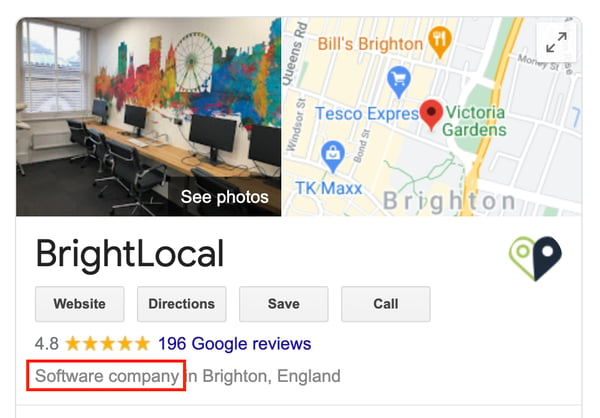
Beyond the singular primary category are secondary (or 'additional') categories, which provide additional details of your business type and services. These are particularly useful if you offer some services that perhaps sit outside the usual offerings of your primary category. For example, if you run a hotel with a popular spa that doesn't serve as a separate business, or if you feel there's a lot of crossover between categories and you want to make sure all bases are covered.
As your category is so important to appearing in the right searches, it's worth testing it for a time in order to ensure you're on the money. Develop a list of five or so suitable primary categories, and change it each week until you've tested them all. Provided you're looking at enough data, you'll be able to see which category led to the most appearances in search.
Not sure where to get this data? No worries; all this is covered in Google My Business Insights, which we'll come to later.
It couldn't be easier to change your GMB categories: simply log into your GMB account, click info, and then click the pencil 'edit' icon shown below.
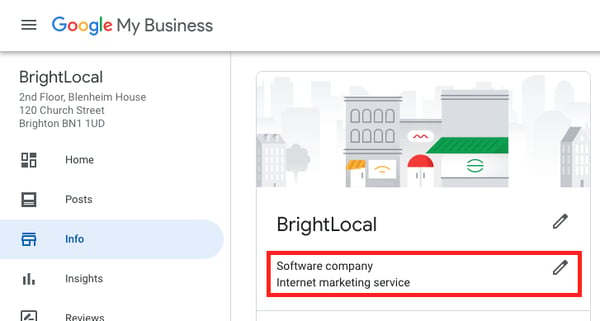
As for your business description, this can be updated on the same page as your category, and while it doesn't have an impact on your rankings, it is a great way for you to tell your audience what makes your business unique.
So much of Google My Business looks and feels exactly the same, business to business, but this is one of the few elements that can be completely unique, so take the time to write something that gets your brand personality across. Be sure to read Google's business description guidelines first.
In order to compete in local search, reviews are absolutely critical. Your online reputation makes up 16% of the individual ranking factors that experts believe Google focuses on for local search, and this figure has risen significantly over the last few years, as the below chart, based on the ongoing Local Ranking Factors Survey shows.
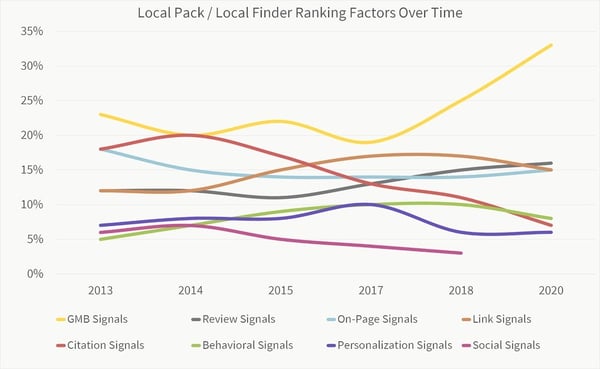
But entirely beside the rankings benefits, there's a clear case for focusing on reviews in order to inform and please your customers. After all, in 2019, 82% of consumers read online reviews for local businesses, and that's not a market you want to miss.
While you might understandably think that the average star rating is the most important part of your Google reviews profile, this figure is actually fairly meaningless unless it's an average of a large volume of consumer views received as recently as possible. A five-star rating garnered from four reviews left over a year ago means nothing to either consumer or Google.
That's why, along with trying to receive positive reviews to boost your star rating, the thing to focus on is your review velocity, or rather, the speed and frequency with which you receive new reviews.
Data from the Local Consumer Review Survey tells us that the average consumer needs to read at least ten reviews before deciding if they can trust a business or not, and that 69% of consumers say that only reviews left in the last month impact their purchase decision.
Based on that logic, you need at least 10 new reviews per month to be making the most of reviews. And yes, the star rating is still important, because 47% of consumers say they only consider using a business if they have four or more stars.
But how do you go about generating new Google reviews? It's quite simple, really: you ask for them! In store, you can ask via signage, you can ask in person after a transaction, you can ask at the bottom of your till receipts. Online, you can ask in customer emails, you can ask on your website, you can ask on your social media profiles. All you need is the link to your Google review profile and the sky's the limit!
It really is a case of "don't ask, don't get," so be absolutely sure you're taking every opportunity to ask for reviews when you can.
Then, when you've amassed a sizable number of reviews and can see that star rating skyrocketing, be sure to highlight this by adding your Google reviews to your website, perhaps with a badge or dedicated widget. There's nothing quite like social proof to improve your chances of converting a local business customer.
A picture speaks a thousand words, and with so few words you can actually control on your Google My Business listing, it makes sense to use as many photos as possible!
Photographs of your business and services take pride of place at the top of your GMB listing, and are even more crucial to get right if you have quite a business where looks are important, such as a restaurant or hotel.
Photos on your GMB listing can be uploaded by the business owner or customers of the business. Customers are often asked to add photos when they leave a review, and while some offer a glorious glimpse into what you offer, many don't provide the best first impression.
According to Google's guidelines on the matter, "to be relevant, photos or videos must be taken by users at the location in question. If the primary subject of the content is irrelevant to the location, it may be removed." You should regularly check your GMB listing to make sure that submitted photos follow these guidelines, and request removal (which can take "several days") if you see something that contravenes them.
While you don't have much control over which photos users choose to upload to your business listing, you can upload a whole host of images yourself. It's something Google really encourages, inviting you to upload multiple types of images and videos in the GMB back end.
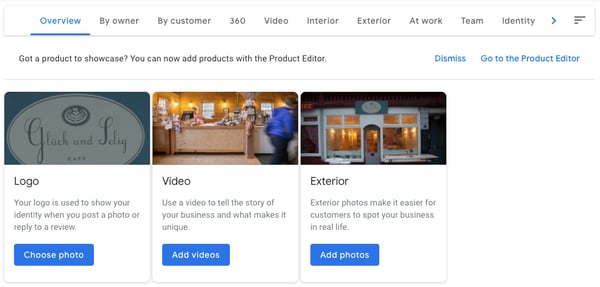
You might think that photos are for purely aesthetic purposes, and wouldn't have much of a bearing on local search performance, but in fact there's a lot of evidence to suggest a strong correlation (not causation, mind) between having lots of photographs on your listing and searchers interacting with your page, so it's certainly worth investing time in high-quality images of your business.
Attributes are an evolving part of the information Google collects and displays about your business. They come in the form of simple statements or phrases that provide details about businesses in a way that makes it easy for searchers and Google Maps app users to make faster decisions.
These attributes are used to surface the right businesses for people looking for specific attributes in their search (e.g. 'dog friendly' when searching for pubs or bars) and they display on the business' Google My Business profile, so users can see they key elements of businesses with ease.
There are two types of attributes: factual and subjective attributes. As the name suggests, factual attributes are facts about the business that can't really be quibbled with (e.g. 'outdoor seating', 'women-led'). These can be set by the business in your Google My Business settings, and the attributes available will be determined by your business category. For example, a business where you pay in-store might have attributes for acceptable payment types available, but a garage door repairman wouldn't.
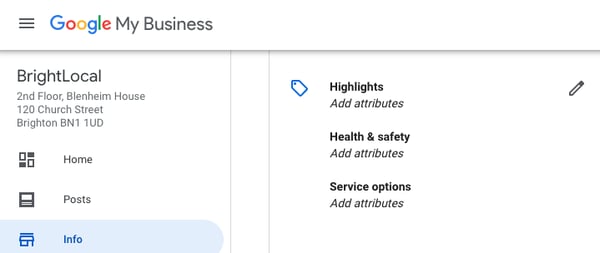
Subjective attributes, on the other hand, are things that your customers have said about your business. These come from Google Maps users, who are often asked via the app which attributes apply to businesses after they've used them. The only way to influence these is, well, to actually be the thing they're asked about. For example, if you want the 'cosy' attribute, you'd better make sure the atmosphere at your restaurant or bar really is cosy!
Google Posts have been around for a while now, but the opportunities they present are in abundance. Each 'Post' is a simple box on your profile containing an image, some text and a call to action, and they're usually around the same length as a tweet. They're there to allow you to make announcements about new products, services, or even just be a bit social.
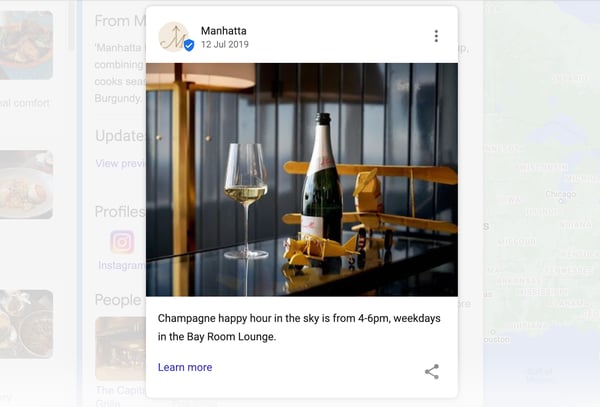
One very popular use is to offer exclusive discount codes with them, and Google actively encourages this by suggesting these as Post types when you start setting one up in the GMB back end. You can also promote competitions, and offer same-day flash sales and seasonal offers.
Google My Business is fairly cookie-cutter as services go, with every profile looking fairly similar. Posts provide a fantastic way for you to break out of this and present your business' personality to potential customers, using graphic design and photos of your business to put your best brand foot forward.
Google Posts are creative, attractive and engaging, so they're definitely worth taking the time to experiment with. While their placement on the GMB profile tends to move about a bit as per Google's whim, there's no doubt that when they can be found, they're sure to make an impact and help you stand out from your competitors.
Q&As on Google My Business profiles are, at best, an untapped opportunity to engage with your audience and to answer common questions, and at worst, a significant risk to your brand if not managed carefully.
Placed fairly prominently on the Google My Business profile, often near reviews, these are questions submitted by profile viewers about your business, and the intention is for your customers to answer them, rather than you as the business owner. In this way, Google aims to create a kind of subjective FAQ for your business.
But why wait until your audience has asked all the right questions? Create your own FAQ by asking and answering key questions about your services and products (you do this via the profile itself, not the back end of GMB).
If you're not carefully monitoring Q&A and answering questions regularly, some "super-helpful" Local Guide might come along and answer them for you.
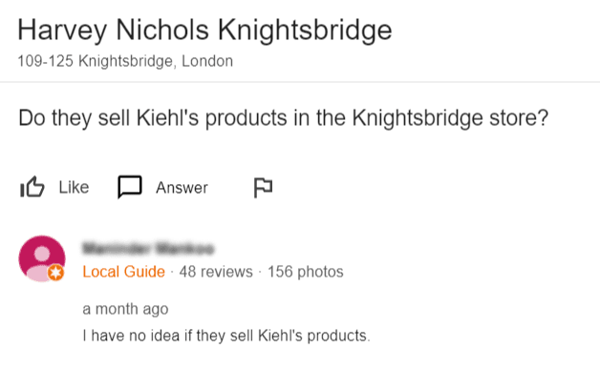
Key word: might. Sigh.
The 'Suggest an edit' link on Google My Business profiles is a crucial one for anyone in an industry that sees lots of what's known as 'name spam' among its competitors.
Name spam occurs when a business decides to break Google's guidelines and fill its GMB business name with keywords denoting services, locations and other qualitative statements, giving it an artificial, and often temporary, boost to local rankings for searches including these phrases.
While it's frustrating that Google's algorithm hasn't yet caught up with guideline-breakers gaming its system, there is something simple you can start to do to report the issues to Google.
Simply visit the spammy business in question, click 'Suggest an edit' and write what the business should be called (the business name on their website is often the best place to find their 'official' business name).
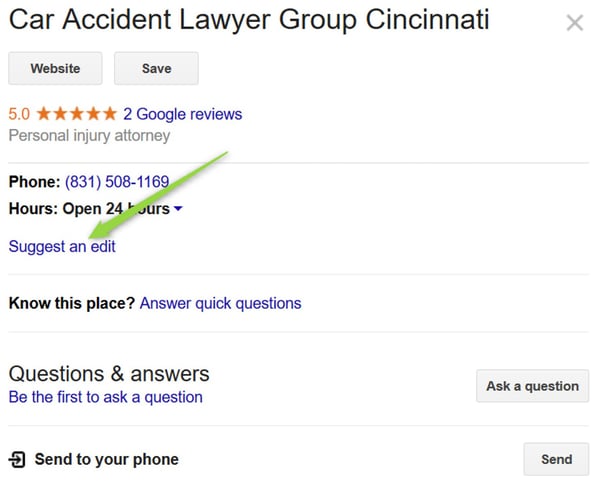
There's sadly no guarantee that Google will take action immediately (if at all), but it's a simple, quick thing you can do on Google My Business that could potentially have a huge impact on your business. After all, once their name is updated, the playing field is far fairer and you could well be looking at a boost to your local rankings, and all the extra footfall and phone calls that brings.
Finally, let's take a look at the performance data center of Google My Business: the Insights section. While it's not considered to be 100% accurate, the various performance metrics provide a good sense of the direction your GMB profile is heading in.

For example, you can see from where and how profile viewers find your business (Is it through Google Search or the Maps app? Is it from a general search query or a specific search for your brand name?) and find out what actions people are taking when they interact with your profile, be that clicking a link to your website, making an in-app directions request or even clicking to call you.
Analyzing how you're performing in these areas, and monitoring the data alongside any improvements you make or tests you run in any of the GMB features mentioned above, gives you a great idea of what's working and what's not. Because of this, Google My Business Insights is a critical part of optimizing your Google My Business listing for optimal performance.
These are eight of the most important Google My Business functions that every business, from a self-employed plumber to an international chain of restaurants, needs to make the most of in order to truly compete in Google My Business.
Local SEO tactics like citation building, local link building and on-site SEO will always help to get your profile listed higher in search, but remember that technology has made consumers far more savvy about purchase decisions, and they're not just going to go with whatever's ranking highest.
Unless your photos are looking lush, your reviews rave about you, your Posts are performing well and your audience's questions are answered, there's far less chance of a potential customer clicking on your profile above a competitor's, so get stuck into these Google My Business features today.
Jamie Pitman is Head of Content at local SEO tool provider BrightLocal. He's been working in digital marketing for well over a decade and has specialized in SEO, content marketing and social media, managing successful marketing projects for clients and employers alike.
Let’s face it — if you want to attract customers, you’ve got to be on Google. And when your...
 by Krystal Taing
by Krystal Taing
You’ve seen the strategies, but putting them all into practice can feel like a lot. Updating...
 by Soundarya Jayaraman
by Soundarya Jayaraman
If you've got a small business, you need to start implementing local SEO.
 by Deana Kovač
by Deana Kovač
Let’s face it — if you want to attract customers, you’ve got to be on Google. And when your...
 by Krystal Taing
by Krystal Taing
You’ve seen the strategies, but putting them all into practice can feel like a lot. Updating...
 by Soundarya Jayaraman
by Soundarya Jayaraman


